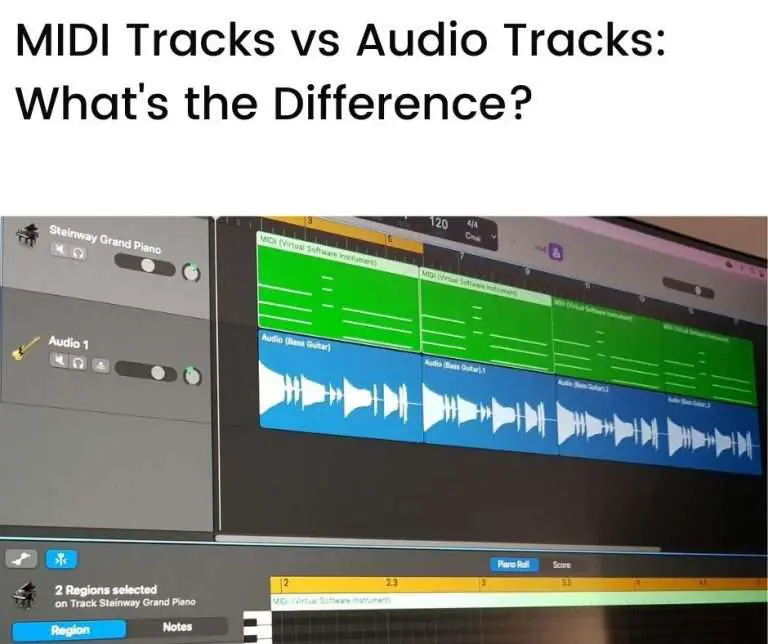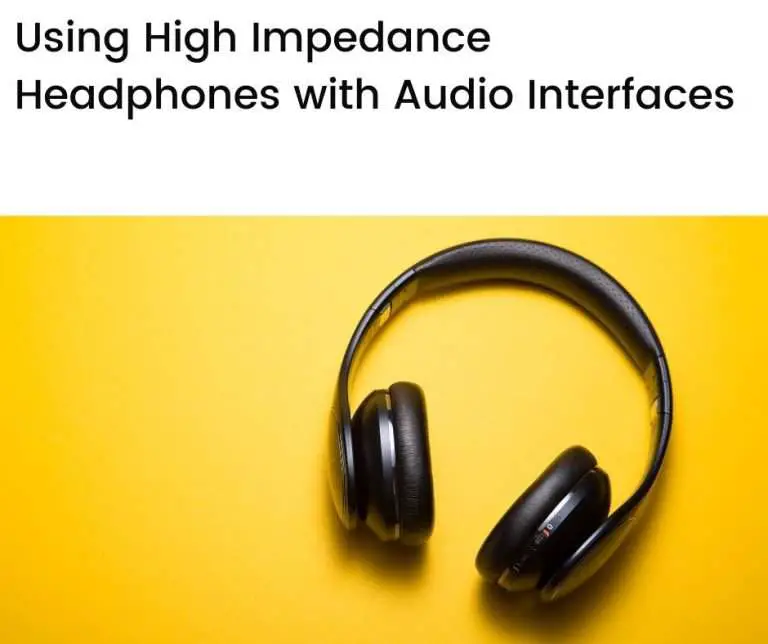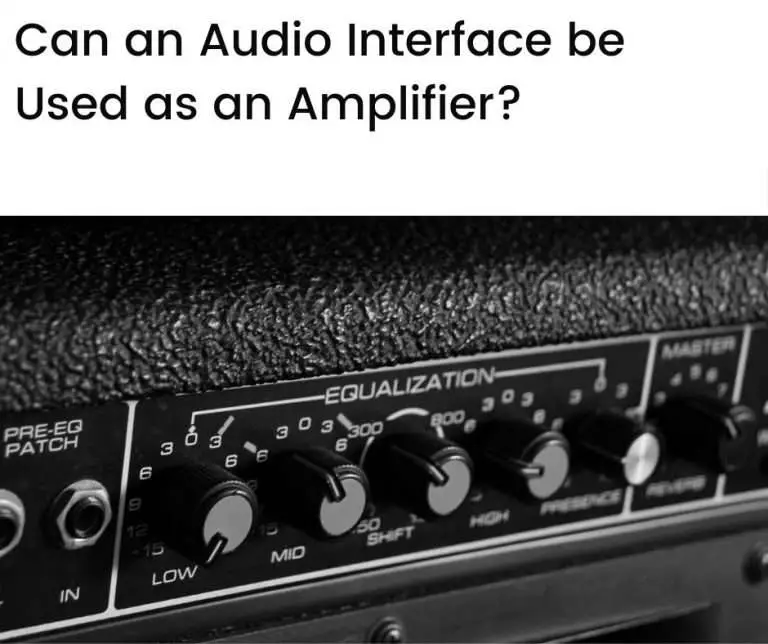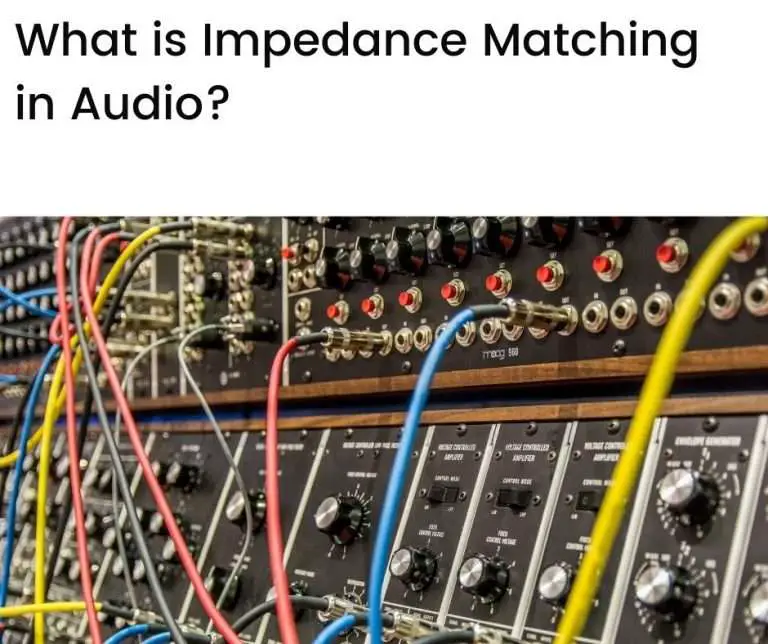Impedance doesn’t directly affect sound quality in headphones. Instead, it indirectly affects sound quality through the way that headphones are made (i.e., their construction) and how they’re paired with source devices. For the best sound quality, pair headphones with source devices that have sufficient power and a similar level of impedance to the headphones. This article explains how it all works.
In this article we’ll look at:
- What is impedance in headphones?
- What are low and high impedance headphones?
- How impedance affects sound quality in headphones
- Is higher impedance better for headphones?
- Conclusion
What is impedance in headphones?
Headphone impedance refers to the degree of “resistance” that headphones offer to a fluctuating current, i.e., an alternating current (AC), flowing through them.
In audio production systems, impedance (rather than resistance) is what matters. This is because the signals in audio systems fluctuate with the frequencies of the audio signals they carry.
And since headphones receive an input signal, it’s headphones input impedance that matters when connected to other equipment such as an amplifier or an audio interface.
What are low and high impedance headphones?
Headphone impedances are typically in the range of 8 Ω to 600 Ω.
Most consumer headphones fall into the lower end of this range (e.g., 8-50 Ω) and are low impedance headphones, but headphones that are at the higher end of the range—100 Ω and above—are high impedance headphones.
How impedance affects sound quality in headphones
Impedance, by itself, doesn’t make headphones sound better. But headphones do sound different depending on their impedance—why?
There are two main reasons why impedance is associated with (but doesn’t directly affect) sound quality in headphones:
- The way that headphones are made, i.e., their dimensions, materials, and weight, results in different impedance characteristics, so the construction of headphones affects the quality of sound produced, and different types of construction have different levels of impedance
- Headphones with different impedances require different amounts of power to drive them, and headphones sound best when they use a power level that suits their impedance
Let’s take a closer look at the characteristics of high impedance vs low impedance headphones.
How headphones are made affects their impedance
All materials have impedance properties, and headphones are no exception.
Headphones are made using a range of materials including PVC, plastic, rubber, synthetic leather, memory foam, ceramics, and copper. The amount and placement of these materials in headphones affect their impedance.
The basic construction of headphones includes a voice coil that’s connected to a membrane.
The voice coil causes the membrane to vibrate (through electromagnetism) in response to audio signals. These vibrations generate sound waves in the air molecules surrounding the membrane, and this is what carries sound to our ears.
The voice coils are the most critical parts of headphones when it comes to sound quality.
They are typically made up of thin strands of copper wire wound around several times (often thousands of times). The thickness of wire used, the number of coils, and how tightly they are wound all have a significant impact on the impedance of headphones.
In general, thicker copper wires have less impedance than thinner wires and can fit fewer windings in a voice coil. They are also heavier, increasing the total mass of the voice coil and diaphragm (which are connected), and are less responsive to audio signals when generating sound waves.
This means that:
- Headphones with voice coils that use thicker wires have lower impedance, fewer windings, and lower sensitivities
- Headphones with voice coils that use thinner wires have higher impedance, more windings, and higher sensitivities
So, different voice coil constructions have different levels of impedance and produce different sound characteristics.
Higher impedance headphones need more power
All else equal, higher impedance headphones draw less current than lower impedance headphones and more voltage. Higher impedance headphones also use more power.
To understand how this works, keep in mind that there are two fundamental relationships in AC electronics:
- The voltage (V) on a circuit is equal to the current (I) running through it multiplied by its impedance (Z), i.e., V = I x Z
- The power (P) of a circuit is equal to the current (I) running through it multiplied by the voltage (V) across it, i.e., P = I x V
The voltage, impedance, and power of source devices
Let’s look at a few examples to see how the power delivered to headphones varies by:
- The source impedance
- The source voltage
- The headphones impedance
The source voltage and impedance are the voltage and impedance of the device connected to the headphones (via a headphones jack), e.g., a laptop, smartphone, headphones amplifier, or audio interface—their characteristics can vary quite a lot.
In general, laptops and smartphones are lower voltage (and lower power) devices while amplifiers, audio interfaces, and professional audio equipment are higher voltage (and higher power) devices.
To illustrate, let’s consider different source voltages and impedances and see their effect on headphones that have a range of impedances from 1–300 Ω.
How headphones’ voltage and power vary for different source impedances
We’ll start by looking at three examples of different source impedances—to keep things simple, we’ll assume a fixed source voltage of 1V in all three examples.
1. Source impedance = 1Ω (source voltage = 1V, headphones impedance 1–300Ω)

In this example, we have a very low source impedance (1Ω). Look at what happens when we gradually increase the impedance of a connected pair of headphones from 1–300Ω:
- The power drawn by the headphones increases rapidly (with a maximum at 1Ω) and then tapers off rapidly
- The voltage across the headphones also increases rapidly—it reaches 95% of its maximum at a headphones impedance of around 20Ω
Notice that the maximum power across the headphones occurs when its impedance equals the source impedance, i.e., when they’re both at 1Ω. This illustrates the concept of impedance matching.
2. Source impedance = 10Ω (source voltage = 1V, headphones impedance 1–300Ω)

Now, we increase the source impedance to 10Ω. In this case:
- The power drawn by the headphones increases less rapidly to reach a maximum at 10Ω and then tapers off
- The voltage across the headphones also increases less rapidly—it reaches 95% of its maximum at a headphones impedance of around 175Ω
3. Source impedance = 100Ω (source voltage = 1V, headphones impedance 1–300Ω)
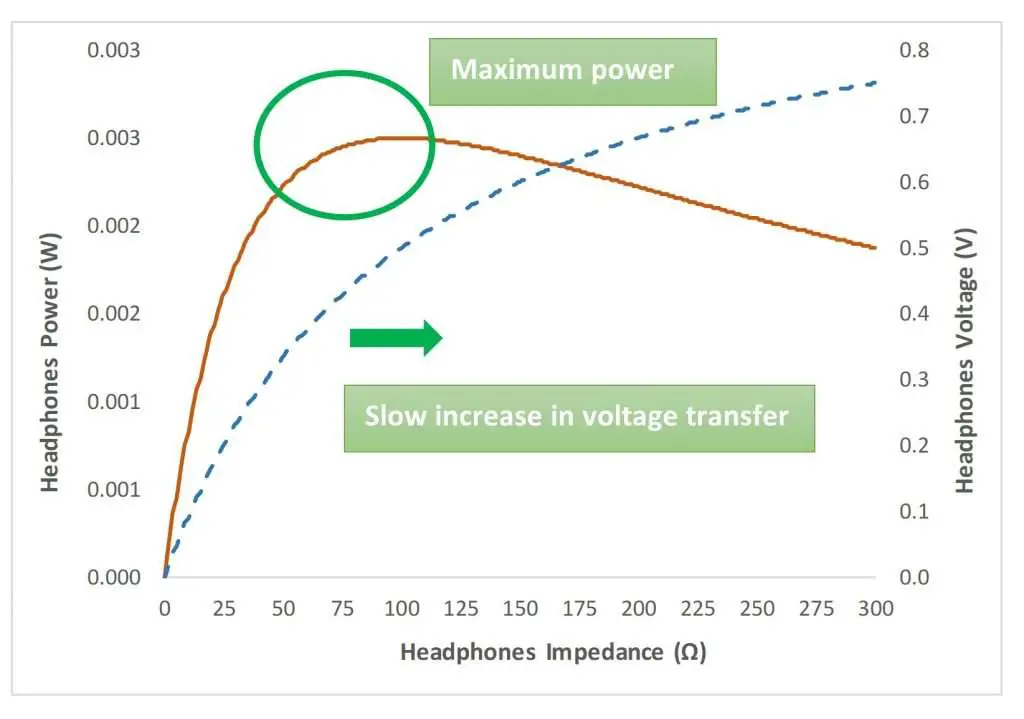
Finally, we increase the source impedance to 100Ω:
- The power drawn by the headphones increases slowly to reach a maximum at 100Ω and then tapers off slowly
- The voltage across the headphones also increases slowly—it reaches 95% of its maximum at a headphones impedance of around 250Ω
What we’ve seen is:
- For low impedance sources, a connected pair of headphones derives a high degree of voltage transfer and maximum power when the headphones also have a low impedance
- For high impedance sources, a connected pair of headphones derives a high degree of voltage transfer and maximum power when the headphones also have a high impedance
How headphones’ voltage and power vary for different source voltages
Let’s now look at three examples of different source voltages—this time, we’ll assume a fixed source impedance of 10Ω in all three examples.
1. Source voltage = 1V (source impedance = 10Ω, headphones impedance 1–300Ω)
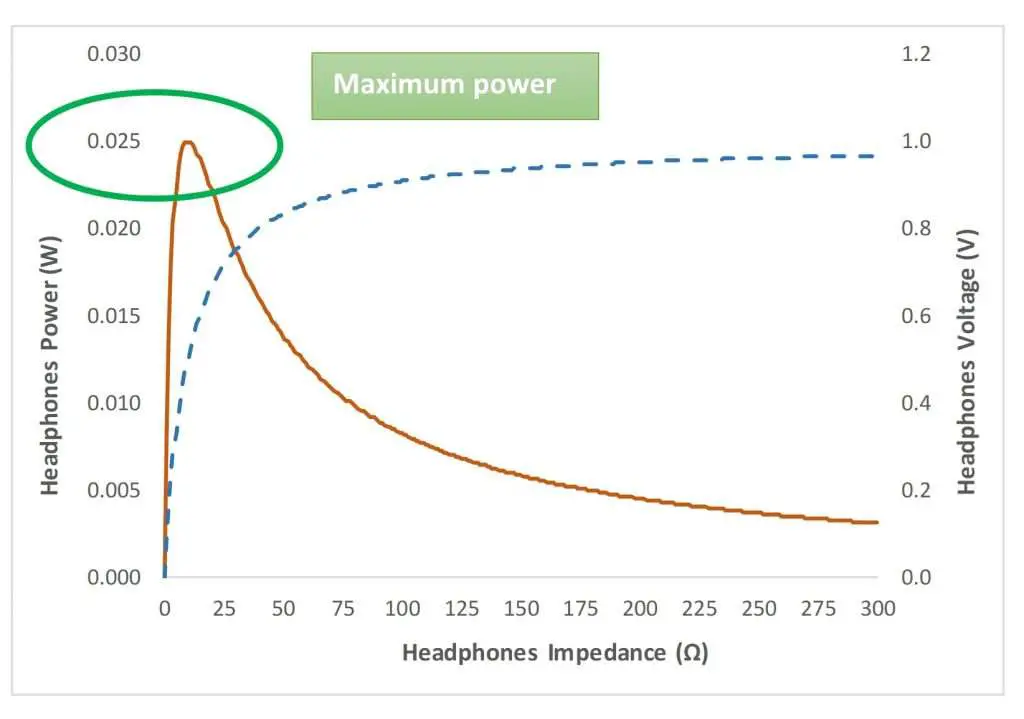
In this example, we have a very low source voltage (1V). As we gradually increase the impedance of a connected pair of headphones from 1–300Ω:
- The power drawn by the headphones increases reasonably rapidly (with a maximum at 10Ω) and then tapers off reasonably rapidly
- The maximum power level is 0.025W (or 25mW)
- The voltage across the headphones also increases reasonably rapidly—it keeps rising but reaches 95% of its maximum at a headphones impedance of around 175Ω
This time, the maximum power across the headphones occurs when its impedance equals the source impedance at 10Ω, once again illustrating the concept of impedance matching.
2. Source voltage = 10V (source impedance = 10Ω, headphones impedance 1–300Ω)
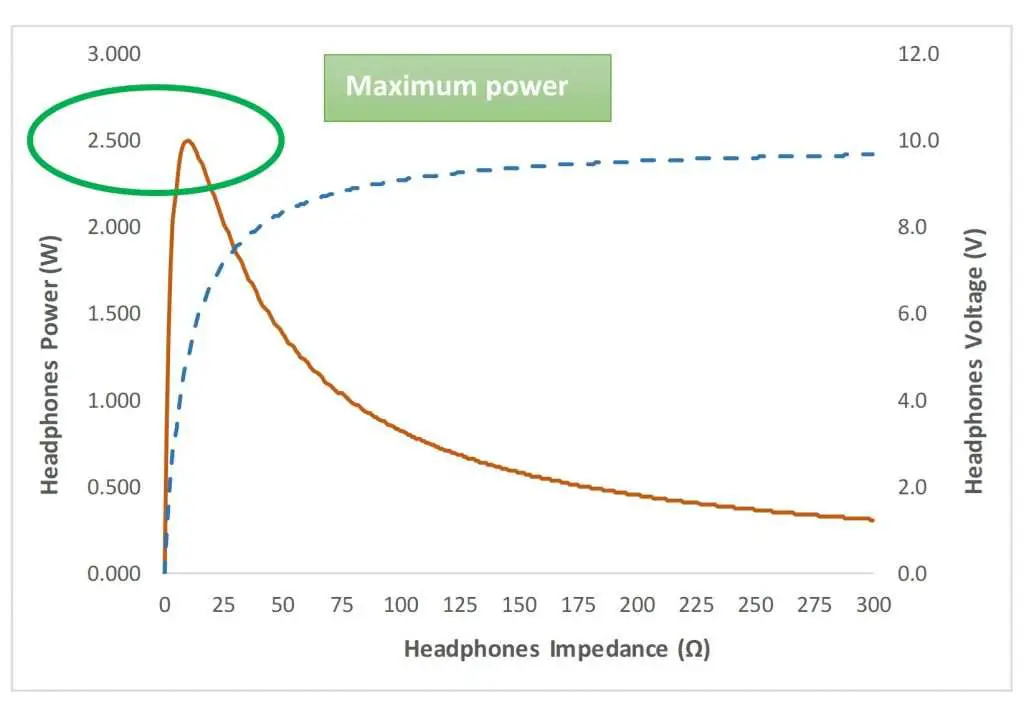
Now, we increase the source voltage to 10V. In this case:
- The shape of the power curve for the headphones is the same as the previous example, but the maximum power level is higher at 2.5W (i.e., it’s 10 x the previous example as the source voltage is 10 x the previous example)
- The shape of the voltage curve across the headphones also has the same shape as the previous example but with a ten-fold increase in voltage levels
3. Source voltage = 100V (source impedance = 10Ω, headphones impedance 1–300Ω)

Finally, we increase the source voltage to 100V. In this case:
- The shape of the power curve for the headphones is, once again, the same as the previous example, but the maximum power level is higher at 25W (i.e., it’s 10 x the previous example as the source voltage is also 10 x the previous example)
- The shape of the voltage curve across the headphones also has the same shape as the previous example but with a ten-fold increase in voltage levels
This time, what we see is:
- For low voltage sources, a connected pair of headphones draws lower power
- For high voltage sources, a connected pair of headphones draws higher power
- For all sources, a connected pair of headphones draws maximum power when its impedance is the same as (i.e., matches) the source impedance
So, how does all this relate to whether lower vs higher impedances are better for headphones?
Read on.
Is higher impedance better for headphones?
A higher impedance isn’t necessarily better when it comes to headphones. Rather, what matters is having an impedance that’s suited to the source you’re connected to.
Also, remember that impedance isn’t the only thing that matters when it comes to sound quality in headphones—the way they’re constructed, i.e., the materials used, the tuning, the overall design, etc., all contribute to headphones’ sound quality.
Pairing headphones with sources
From what we’ve seen, there are two ways to pair headphones with connected sources to produce good results:
- Choose sources with sufficient voltage to produce enough power for the headphones being used
- Choose headphones with an impedance that (more or less) matches the source impedance to derive maximum (or most) power from the source
Examples of low voltage, low power source devices are smartphones and laptops.
Examples of higher voltage, higher power source devices are headphone amps or mains-powered audio interfaces.
So, for the best results, you should connect:
- Low impedance headphones with low voltage and power sources like smartphones and laptops
- High impedance headphones with high voltage and power sources like amps and mains-powered audio interfaces
When you pair your headphones in this way, you’ll get the best results in terms of sound quality, e.g., good volume, solid bass, better transparency, and more clarity of sound.
What about mismatched pairing of headphones with sources?
What happens if you don’t pair your headphones well?
If you connect high impedance headphones with a low power source, for instance, you won’t get as much volume and you may have to turn the source volume to its fullest. The lack of volume means that your headphones won’t sound as good as they should.
On the other hand, if you connect low impedance headphones to a high power source, you should be careful not to turn the source volume too high as this could distort the sound that you hear, or worse, damage your headphones.
If in doubt, it’s safer to use higher impedance headphones as they can handle more power.
But for the best results, as we’ve discussed, try to use headphones with an impedance level that’s close to the source you’re using.
But isn’t impedance matching no longer important for modern audio systems?
You may have heard that impedance matching no longer matters for modern audio systems.
That’s true, but it depends.
Impedance matching still has a role to play in pairing amps with speakers, or as we’ve discussed, when pairing source devices with headphones. This is because, as we’ve seen, impedance matching maximizes power transfer.
But impedance matching doesn’t necessarily help in other parts of an audio workflow because in those parts we want to prioritize signal transfer rather than power transfer.
When connecting an instrument or microphone, for instance, to a device such as an audio interface, we want to transfer as much as possible of the audio signal (i.e., voltage) from the instrument or microphone to the audio interface. In these cases, we want a high input impedance (on the audio interface) relative to the low source impedance (on the instrument or microphone).
Why?
Because the signals from instruments or microphones are very low and we want to transfer as much of this as possible while preserving the signal’s fidelity. Power transfer isn’t a priority.
And as we’ve seen, to get more voltage transfer we need to have a high input impedance relative to the source impedance. This is why there are high impedance inputs on devices like audio interfaces to help transfer a high proportion of the input signal from (weak) sources.
Conclusion
Choosing a great pair of headphones can be confusing. The different materials used to make them, how they’re put together, and their various design features can all affect the way that headphones sound.
And when it comes to how impedance affects sound quality in headphones, keep in mind that it doesn’t have a direct effect. Instead, it has an indirect effect based on:
- How your headphones are made, i.e., what materials are used to make them, where they’re placed, and in what quantities
- How you pair your headphones with source devices
When pairing your headphones:
- Pair with source devices that have sufficient power (or voltage) to drive your headphones, i.e., use low power devices (e.g., laptops or smartphones) with low impedance headphones and higher power devices (e.g., amps or mains-powered audio interfaces) with higher impedance headphones
- Pair with source devices that have a similar level of impedance to your headphones to maximize power transfer
Following these simple principles will help you get the best sound quality from your headphones depending on its impedance.



